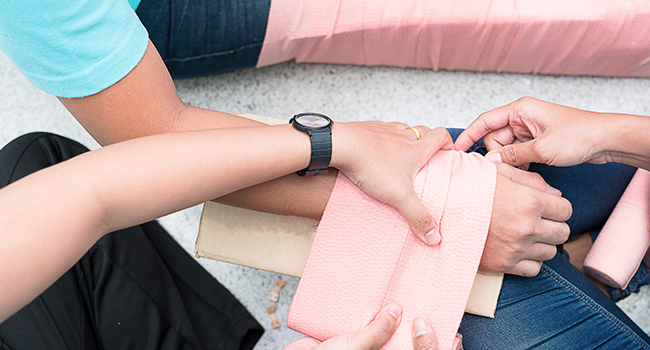
Broward Teachers Train to “Stop the Bleed”
During “Stop the Bleed” training, participants learn to dress fake gashes and bullet wounds, as well as use tourniquets. The goal is to be able to stop bleeding and begin to take care of significant wounds in an emergency before paramedics arrive on the scene.
- By Jessica Davis
- November 05, 2018
During the last eight weeks, almost 6,000 teachers and staff members at more than 85 Broward County public elementary, middle and high schools in Florida have completed a “Stop the Bleed” training course for emergency and first aid.
The national “Stop the Bleed” training began in Davie, Fla., in 2014. Some Broward County teachers had received training previously, but emergency officials worked with the county to expand the training to more people after the Parkland, Fla., shooting that took place earlier this year.
It wasn’t until this summer that enough funding was available to implement the training in every public school in the county. The training is now offered to teachers and staff in all Broward County Public Schools.
During “Stop the Bleed” training, participants learn to dress fake gashes and bullet wounds, as well as use tourniquets. The goal is to be able to stop bleeding and begin to take care of significant wounds in an emergency before paramedics arrive on the scene.
"I like to say that it's the new CPR for bleeding control," said Candace Pineda, the administrative director of trauma and acute care surgery at Memorial Regional Hospital, who also leads trainings. "Once they realize it's not all on their shoulders, it kind of gives them a sense of ownership and control that they know what to do, rather than feeling helpless."
Julie Osheroff, a 4th grade math and science teacher who participated in training Wednesday, was nervous about the hour-long course but learned a lot.
"I definitely learned things today that I had never heard before," Osheroff said. "We watch these kids get hurt all the time, but they're little scrapes, they're little paper cuts - not this massive, gushing wound...the more you learn about it, the more we can do."
Each school that completes the training is given at least one “Stop the Bleed” kit to keep on campus. The kits include a tourniquet, gloves and first aid supplies like gauze.
"Any of these kind of trainings just makes it very real that we could be in this situation," Osheroff said.
About the Author
Jessica Davis is the Associate Content Editor for 1105 Media.